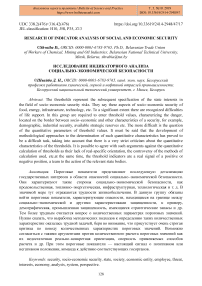Research of indicator analysis of social and economic security
Автор: Shvaiba Dzmitry
Журнал: Бюллетень науки и практики @bulletennauki
Рубрика: Экономические науки
Статья в выпуске: 10 т.5, 2019 года.
Бесплатный доступ
The thresholds represent the subsequent specification of the state interests in the field of socio-economic security risks. They say these aspects of socio-economic security of food, energy, infrastructure, technology, etc. To a significant extent there are recognized difficulties of life support. In this group are required to enter threshold values, characterizing the danger, located on the border between socio-economic and other characteristics of a security, for example, demographic, industrial security, available strategic reserves etc. The more difficult is the question of the quantitative parameters of threshold values. It must be said that the development of methodological approaches to the determination of such quantitative characteristics has proved to be a difficult task, taking into account that there is a very strict criticism about the quantitative characteristics of the thresholds. It is possible to agree with such arguments against the quantitative calculation of thresholds as their lack of real-specific orientation, the controversy of the methods of calculation used, etc.at the same time, the threshold indicators are a real signal of a positive or negative position, a team to the action of the relevant state bodies.
Security, socio-economic security, state, society, economic entity, employee, threat, interests, economy, analysis, system, perspective
Короткий адрес: https://sciup.org/14115068
IDR: 14115068 | УДК: 338.2(476)+316.42(476) | DOI: 10.33619/2414-2948/47/17
Список литературы Research of indicator analysis of social and economic security
- Shvaiba D. Dynamic regression models of forecasting indicators of social and economic security // Бюллетень науки и практики. 2019. Т. 5. №1. С. 249-257.
- Shvaiba D. Industry of the Republic of Belarus: problems of social and economic security // Бюллетень науки и практики. 2018. Т. 4. №9. С. 245-252.


